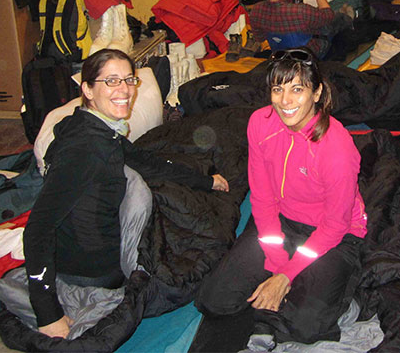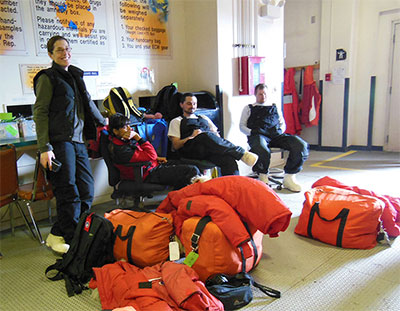Retrieving Meteorites at the South End of the Earth
 During the winter months it is a tradition for many Canadians to head south, but Marianne Mader has gone a bit further than Florida by 10,400 kilometers. The Ph.D. student in Earth Sciences and Planetary Science who studies Impact Cratering in Dr. Gordon Osinski's lab has been selected as the only graduate student in a team of researchers and an astronaut to search for meteorites in Antarctica. For the past 30 years, teams assembled by Case Western University have made this expedition funded by the National Science Foundation in the United States.
During the winter months it is a tradition for many Canadians to head south, but Marianne Mader has gone a bit further than Florida by 10,400 kilometers. The Ph.D. student in Earth Sciences and Planetary Science who studies Impact Cratering in Dr. Gordon Osinski's lab has been selected as the only graduate student in a team of researchers and an astronaut to search for meteorites in Antarctica. For the past 30 years, teams assembled by Case Western University have made this expedition funded by the National Science Foundation in the United States.
Although meteorites fall to Earth all over the globe, the Antarctic provides one of the best settings to gather meteorites. What makes Antarctica a preferred area to for the search parties is that some meteorites fall on slow moving ice sheets free from soil. “As the ice sheet is moving, it is moving towards the Trans Antarctic Mountain Range,” says Mader. It is at this point where the ice slows down and dries up leaving behind the meteorites where the team can scan the area. “They have been focusing their collection efforts along this mountain range. Most years they have two field parties, a much smaller one of four people that does reconnaissance so they scout about for new areas… and then a larger team, which I’m a part of, made up of eight people and we go to known sites where they know there are meteorites. It’s a matter of systematically going, surveying them and collecting them.”
“There are rocky exposures , so there are some other kinds of rock that could be found there in some areas where we are collecting, but these black rocks that’s what we’re looking for they stand out really well and a lot of them are meteorites.”
Living in the Antarctic will present a number of challenges but the first obstacle Mader had to face was being selected by the program. For her, the process began by accessing the website of Ralph Harvey, the principle investigator of the expedition, at Case Western. “It’s an interesting application process, I wouldn’t say it’s traditional … when you get to the application process it basically says to write a letter saying why you want to go and when your available to go and that’s the application, and you have physically mail it.” Surprisingly she says many people find that to be a barrier. “I first heard of the program four or five years ago and I wanted to go to Antarctica for quite a while. I had done research in the Canadian high arctic and when I first heard about the program, I thought ’that’s it, that’s how I can go’ so I started writing letters three years ago knowing that I wouldn’t be able to go until this year or next year.” After getting no response the first time, Mader continued applying every year. “This past year I wrote and I said actually this is the year I want to go and the stars aligned. It is not a guarantee that you will get selected and they tell you on their web site that there priority is people who have gone before, veterans, people who are using samples as part of their primary research who work on meteorites and the third category is everybody else and I technically fall into that third category because my research is not directly related to meteorites, I work on impact craters.”
 When she was notified via email that she had been selected Mader was elated. “That was definitely up there as one of my all time most exciting moments. I was sitting with my husband when I got the email and the only other comparison I have is that actually I proposed to my husband and that moment of being so excited that it was the same kind of intense feeling,” she added. “I feel incredibly fortunate.” Being accepted in the program is in itself not a guarantee that you’re going. “You have to pass all these physical exams which were pretty extensive, I feel that I’m pretty healthy, I know that now. You have to be physically qualified to go and after that you get the stamp of approval.” Her role is solely collecting samples. “When you are part of the search party, we collect the samples, we don’t even identify them in the field in so much that you see a black rock and there are certain features, but then the samples are shipped back on ice to NASA at the Johnson Space Centre and they go on to the Smithsonian and that’s where they’re identified and that’s where they use scientific analysis.”
When she was notified via email that she had been selected Mader was elated. “That was definitely up there as one of my all time most exciting moments. I was sitting with my husband when I got the email and the only other comparison I have is that actually I proposed to my husband and that moment of being so excited that it was the same kind of intense feeling,” she added. “I feel incredibly fortunate.” Being accepted in the program is in itself not a guarantee that you’re going. “You have to pass all these physical exams which were pretty extensive, I feel that I’m pretty healthy, I know that now. You have to be physically qualified to go and after that you get the stamp of approval.” Her role is solely collecting samples. “When you are part of the search party, we collect the samples, we don’t even identify them in the field in so much that you see a black rock and there are certain features, but then the samples are shipped back on ice to NASA at the Johnson Space Centre and they go on to the Smithsonian and that’s where they’re identified and that’s where they use scientific analysis.”

